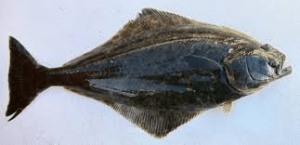
I had planned to wrap up my series of blog posts on halibut last week, but then I realized I’d left unanswered questions, including some of the questions our guests most frequently ask us about halibut. Last week, I attempted to explain the complicated system and the agencies involved in regulating both the commercial and sports fisheries for halibut, so I’ll stay away from regulations here. If you would like to know more about halibut fishing regulations, let me know.
How old is my halibut?
It is very difficult to age a halibut by looking at it. Females grow much faster and larger than males, so a 40 inch (102 cm), 30 lb.(13.6 kg) male might be 20 years old, while a female that size could be as young as six-years-old. Growth rates also vary widely between individuals of the same sex. Scientists age halibut by counting the growth rings laid down on the otolith, a bony structure in halibut’s inner ear. The rings on an otolith are counted in the same manner a tree’s rings are counted to determine the age of a tree. Research has determined most halibut landed by a sports fishermen average between five and 15 years.
Is my halibut a male or female?
A halibut’s gonads are found at the bottom of the gut cavity. If the halibut is a female, the ovaries are triangular, hollow sacs that have a light pink tint. The testes in males appear solid and rubbery and are gray.
How much meat will I get from a 50-lb fish?
You should recover 50 to 60% of the total weight of the fish as edible meat. A 50-lb. (22.7 kg) fish will produce 25 to 30 lbs. (11.4 kg – 13.6 kg) of beautiful, boneless fillets.
What is a chalky halibut?
Sometimes the meat of a halibut, especially a smaller halibut, will appear opaque white instead of translucent when it is filleted. While this chalky meat may taste slightly drier than opaque meat, there is nothing wrong with the meat. Chalkiness is caused by a build-up of lactic acid in the flesh when the halibut over-exerts itself while it is fighting as the fisherman hauls it to the surface. Warmer water temperatures also seem to be a factor in causing increased lactic acid in the fish. In Alaska, 5% of all halibut caught are chalky.
How well do halibut survive catch and release?
Unlike rockfish or cod, halibut do not have an air bladder, or swim bladder, which expands from changes in water pressure, so halibut do not suffer as much when brought to the surface. Research has found that sport-caught halibut handled gently have a 95% survival rate.
My halibut turned to mush when I cooked it. What did I do wrong?
Oops! It may have looked like a small halibut, but you probably caught an arrowtooth flounder. Arrowtooth flounder are dusky colored on the “white” side, have larger scales than a halibut, and needle-like teeth in their long mouth. These flounder have an enzyme that when activated by heat, makes their flesh dissolve.
___________________________________________________________________________
That’s all I have on Pacific halibut, but I would love to hear questions and comments from you. Next, I will tackle Pacific salmon, but first, next week, I need to tell you about my spring and summer. This has not been the best year for me, but I hope by writing about it, I can turn things around so my end-of-the-year post will be about how great the last few months of 2017 were!
You can always cheer me up by signing up below for my free, monthly newsletter about true crime in Alaska. This month, my newsletter tells the story of a woman murdered by a car bomb in downtown Anchorage and the war her brother waged against the man he was certain had murdered her.




